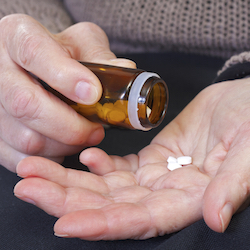Osteoarthritis
Plant Extracts Superior for Managing Osteoarthritis
Plant extracts may not be as potent as taking ibuprofen for osteoarthritis. Their subtlety is a positive says, Michael Jurgelewicz, DC. “They have an action that spreads across multiple enzyme systems, which is often a better way to go because you get the effect you want without the potential downstream side effects such as edema, hypertension, ulceration, or renal dysfunction,” he writes.
Adults Children of Alcoholics and Drug Abusers More Likely to Develop Arthritis
According to a study by University of Toronto, the adult offspring of parents who were addicted to drugs or alcohol are more likely to have arthritis. Investigators examined a group of 13,036 adults and found that 20.4 per cent of respondents had been diagnosed with arthritis by a medical professional. Investigators found that 14.5 per cent of all respondents reported having at least one parent whose drug or alcohol use caused problems while were under the age of 18 and still living at home. The Association between a History of Parental Addictions and Arthritis in Adulthood: Findings from a Representative Community Survey, published in International Journal of Population Research, Volume 2014
Osteoarthritis Research Review
In May 2013, Harvard Medical School published a report on osteoarthritis in their Women’s Health Watch. In the report, they looked at “on-the-horizon therapies” that could change the way you treat the disease. In the report, Dr. Anonios Aliprantis made statement that should have made doctor’s rethink the way they treat OA. “We’re beginning to understand that osteoarthritis is a disease of the entire joint,” said Aliprantis, director of the Osteoarthritis Center at Harvard-affiliated Brigham and Women’s Hospital. “Much of the research over the last 20 or 30 years has focused on cartilage as the target. But we’re beginning to realize that there are important changes happening in the bone underneath the cartilage, and in the joint lining itself. As we begin to understand osteoarthritis as a disease of the entire joint, new treatment targets will emerge.”
Integrative Nutritional Approach to Rheumatoid Arthritis
This archived case study Dan Lukaczer, ND is a useful model for practitioners seeking to develop a nutritional approach to treating arthritic symptoms. As Lukaczer points out in this case study, the relationship between rheumatoid arthritis [or any form of arthritis] and the myriad potential environmental triggers is beyond the scope of this report. Instead, this paper addresses the use of a focused nutritional support program and discusses select environmental influences to illustrate the rationale behind this clinical approach. Given the complexity of RA, no one approach can benefit all patients, but it is hoped that the case illustrated here will show how a nutritional program can be personalized, leading to a clinically-beneficial result. Registered users and Today’s Practitioner members can access the entire case study.
Integrative Nutritional Approach to the Treatment of Rheumatoid Arthritis, Published in Integrative Medicine, A Clinician’s Journal Vol. 4, No. 2 by Dan Lukaczer, ND
Flavocoxid for Osteoarthritis: Efficacy and Safety
OPINION Dietary habits have been shown to influence the metabolic and inflammatory processes involved in Osteoarthritis (OA). Lower intake of antioxidants is associated with increased incidence of OA while an increased intake of flavonoids and omega-3 polyunsaturated acids decreases production of inflammatory mediators and the incidence of OA. This report will focus on the detailed preclinical and clinical investigation of flavocoxid, an anti-inflammatory medical food composition marketed for the metabolic management of OA. Published in Nutrition and Dietary Supplements, May 2010, by Robert Levy, Lakshmi Pillai and Bruce Burnett.
Flavocoxid: Dual Inhibitor of Cyclooxegenase and 5-Lipoxegenase
Integrative medicine clinicians from various professional backgrounds and fields are encountering an ever-growing population of patients/clients suffering from acute and chronic pain conditions, many of these being inflammatory in nature including; sports injuries, degenerative and inflammatory arthritis, autoimmune-related disorders, and many more. Many of these patients experience significant gastrointestinal, renal, and coagulation side-effects, and more, and may not even be aware of them until they cause a serious medical disorder. There are emerging highly standardized and evidence-based natural agents that effectively modulate the same enzyme pathways as anti-inflammatory medications with much lower side-effect profiles. One such extract with strong supporting human outcome studies, flavocoxid, will be discussed in this article with emphasis on its safety profile and balanced action across a multitude of inflammatory pathways.
Published in Nutritional Perspectives: Journal of the Council on Nutrition of the American Chiropractic Association, Vol. 36, No. 3, by David Brady, ND.
WHITE PAPER: Managing the Metabolic Processes of Osteoarthritis with Medical Foods
Osteoarthritis is characterized as a chronic condition, whereby cartilage tissue that cushions joints breaks down, causing stiffness, pain and loss of joint movement. It is a gradually occurring condition that is often perceived by patients as a nuisance and a normal symptom of aging, until the stiffness and pain becomeRead
Neurogenic Inflammation in OA: Combined Thermal Therapy with Acetaminophen
Symptomatic drugs are frequently used for pain control, but dissatisfaction with such an intervention has led many patients to seek other treatments, one of which is thermal heat. The intentions in the present study is to investigate a possible interaction between thermal treatment and the main neuropeptides involved in OARead
Breakthroughs in Arthritis – The BMP Connection
Osteoarthritis, also known as degenerative joint disease, is one the most common forms of joint disorder in the United States and affects over 20 million people. Current treatments for its management involve the use of analgesics such as acetaminophen and nonsteroidal, anti-inflammatory drugs (NSAIDs). These treatments, however, have shown…











